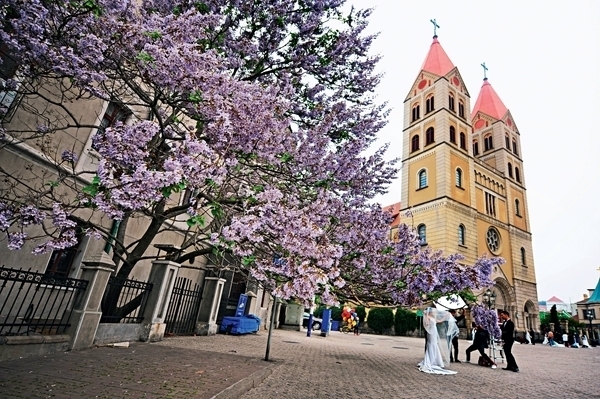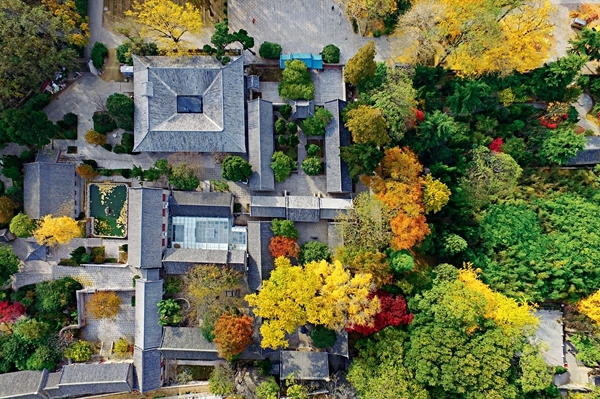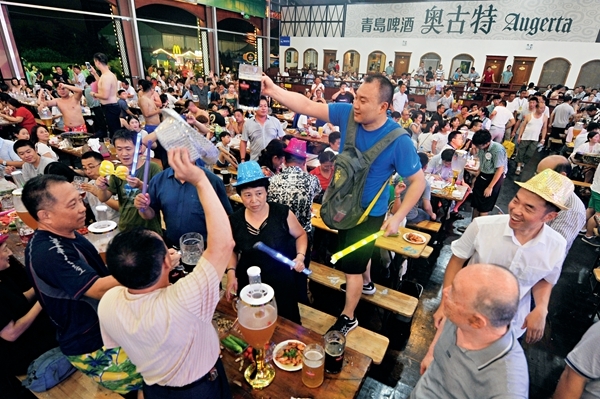Qingdao: East meets west
 0 Comment(s)
0 Comment(s) Print
Print E-mail China Today, June 20, 2017
E-mail China Today, June 20, 2017
Qingdao is located on the southern coast of the Shandong Peninsula, just across the Yellow Sea from the Korean Peninsula.
This coastal city boasts outstanding scenery and a pleasant climate. With seaports and an airport linking it to the world, Qingdao is one of China's most important economic and logistics hubs.
|
|
|
Old Western-style buildings embellish Qingdao with exotic beauty. |
Moreover, it is a renowned tourist resort with gorgeous mountain and sea landscapes. A past winner of the China Habitat Award, Qingdao attracts hordes of visitors every year, particularly during its international beer and seafood festivals in August.
Exotic Beauty
As early as the Neolithic Age, Qingdao was a major center of human life and civilization, home to the rich and colorful Dawenkou, Longshan and Yueshi cultures.
Qin Shihuang (259-210 BC), the first emperor to unify China, visited Qingdao three times during his five nationwide tours. But Emperor Wudi (156-87 BC) of the Han Dynasty (206 BC - AD 220), a former prince of eastern Shandong, was the monarch who visited the Qingdao region most frequently.
With its strategic location easily connecting it to the south of the country via sea, Qingdao has been one of northern China's leading transportation hubs and commercial ports since the seventh century.
|
|
|
An aerial view of the Taiqing Palace on Laoshan Mountain. |
Meanwhile, it has always played a key role in defending China's shores. In 1891, the central government of the Qing Dynasty (1644-1911) set up a garrison in the area and Qingdao has enjoyed city status ever since.
In 1897, Germany occupied and colonized Qingdao on the pretext of leasing land from China. The Germans built ports and railways in the city, boosting local development. In the northern and southern parts of the city, a good number of examples of old Germanic architecture can still be found today.
After Qingdao was occupied by the German forces, Western-style buildings started to emerge in such areas as Badaguan and Kaiser-Wilhelm-Ufer (today known as Taiping Road). Most of them are brick-and-timber constructions.
The Germans used granite from Laoshan Mountain in southeastern Qingdao and brought over steel from their home country. Large buildings were often embedded with granite or plates.
The roofs varied in style, while the gables resembled medieval pastoral elegance. Doors and windows were usually exquisitely decorated. Surrounded by trees and flowers, and set against a backdrop of green mountains and blue water, these Western-style buildings make the city more colorful.
|
|
|
The annual International Beer Festival is held in Qingdao each August. |
Red-tiled roofs and lush trees are a scenic feature of Qingdao, and Badaguan in the east of Huiquan Bay, is a fine example. Over 200 detached villas line tranquil roads in this district, each boasting a unique design and structure, but with a garden and sea views for every residence. The buildings, in such styles as Russian, British, French, German, American, Danish, Greek, Spanish, Swiss, Japanese, to name but a few, make the area a real showcase of world architecture.
Guantao Road in the north of the city was first built in 1899. Known as the Kaiser Stra?e during the German occupation, it was adjacent to the railway station, port and customs, making it a perfect location for business and trade.
Back then, the road was a hub for foreign companies. It was always the first stop for businesses from different countries setting up their branch offices in Qingdao. Thriving import and export trade in the early 20th century attracted foreign banks, and this allowed Guantao Road to grow into a financial and economic center, exerting influence on eastern China's economy and on export and re-export trade in the nation's coastal regions. Today, it has been restored as a German-style road and 25 colonial-era buildings are well preserved on this one-km-long street.
Beer City
In China, Qingdao is often synonymous with beer. The pride of the city, Tsingtao Brewery Co., Ltd., was founded by German and British settlers in 1903. Tsingtao beer, brewed with barley, yeast, and pure spring water from Laoshan Mountain, has been recognized as the finest beer in China ever since winning a gold medal at the Munich Exposition in 1906.
Tsingtao Brewery Co., Ltd. was the first company from China's mainland to be listed overseas and its beer was one of the first Chinese brands to enter the international market. Tsingtao beer has so far been sold in more than 80 countries and regions including the U.S., Japan, Germany, France, the U.K., Italy, Canada, Brazil, and Mexico. According to a report released by Barth-Haas Group, Tsingtao Brewery Co., Ltd. is the sixth largest brewery worldwide in terms of production.
On the streets of Qingdao, you can see locals carrying beer around in plastic bags. It may look strange, but this is the way Qingdao people prefer to drink their beer, believing that the taste of beer out of a bottle can never match the taste of beer poured straight from the barrel.
Once they reach home, they hang the bag on a door and pierce a hole through it to drink the beer down. Nothing is more refreshing during hot summer days and most locals prefer to consume beer this way throughout their lives. Keeping beer in plastic bags is a unique local custom which amazes visitors to the city, but beer is truly indispensable in Qingdao and, in a way, brings people closer together.
August is the best time to visit the city -- the 16-day International Beer Festival always commences on the second weekend of the month. Since 1991, the event has been one of Asia's biggest booze fests, attracting numerous brewers from China and overseas. During this time of year, an aroma of malt permeates the city.
Drinking beer, eating seafood and swimming in the sea are considered must-do activities in Qingdao.
Birthplace of Taoism
Laoshan, in the east of Qingdao, is a major mountain on the Shandong Peninsula. Rising to 1,132.7 meters above sea level, it is the highest mountain on China's coastline. What's more, Laoshan is a birthplace of Chinese Taoism.
The earliest Taoist culture on the mountain can be traced back to the eighth century BC, when a group of people gathered here to pursue immortality by practicing alchemy. By the third century BC, Laoshan was thriving as a well-known sacred mountain.
According to Taoism, a religion of Chinese origin that has played an important role in traditional Chinese culture, the Tao gives rise to all being. Worshipping various kinds of deities, Taoists pursue immortality and celestial existence, while striving to benefit mankind.
The religion flourished on Laoshan from the 13th to the 17th century. As many as nine palaces, eight temples and 72 convents were scattered across Laoshan's valleys and peaks, where large numbers of believers offered incense and prayed. Interestingly, some of the Taoist structures on the mountain were shared by Taoists and Buddhist monks.
Today, 13 old palaces and temples remain, including the Taiqing, Shangqing and Taiping Palaces, and the Memorial Temple for Guan Yu. Yuqing (Jade Purity), Shangqing (Highest Purity), and Taiqing (Virtuous Purity) are the three supreme deities of Taoism, embodying its core philosophy of "Tao produces one, one produces two, two produces three, and three produces everything." The three supreme deities are believed to reside in a faraway, mysterious celestial realm, controlling other deities and the universe while watching over human society.
In the Chinese language, the phrase "Taoist priest from Laoshan" often refers to mysteries and magic. It originates from a story in the classical Chinese work, Strange Tales from a Chinese Studio, written by Pu Songling during the Qing Dynasty.
It tells the story of a young man who left his family and journeyed to Laoshan upon learning that the priests there were adept at Taoist magic. However, he was too pampered to endure all the hardships the priests had and achieved nothing in the end. In the story, Pu Songling depicted various myths and legends about Taoist priests. For instance, they had the ability to walk through walls, turn a round piece of paper into the moon, turn a chopstick into the goddess of the moon, and keep bottled wine flowing endlessly, among many other skills. Hence, Taoists priests from Laoshan often have an air of mystery.








